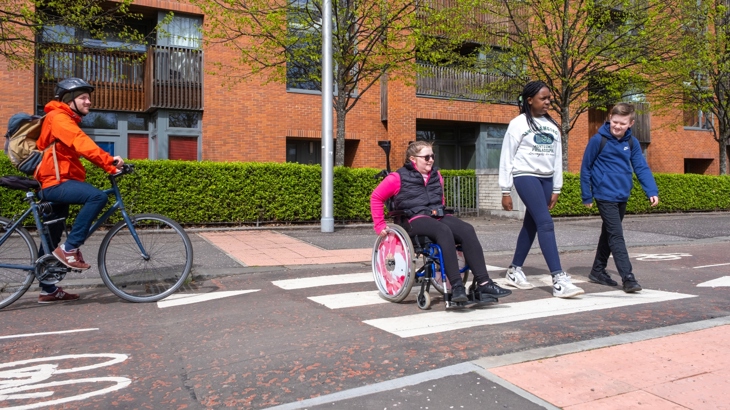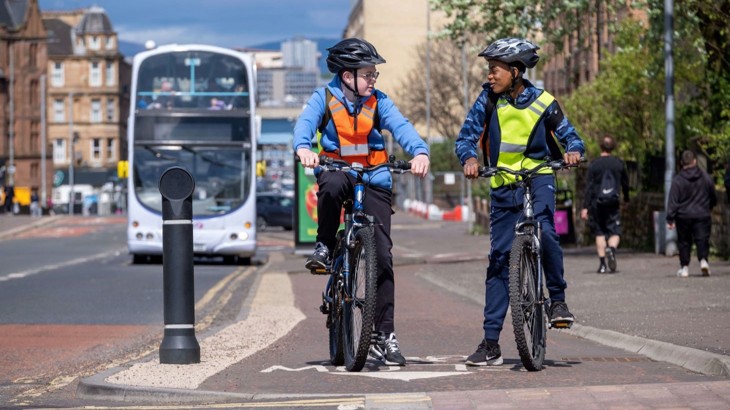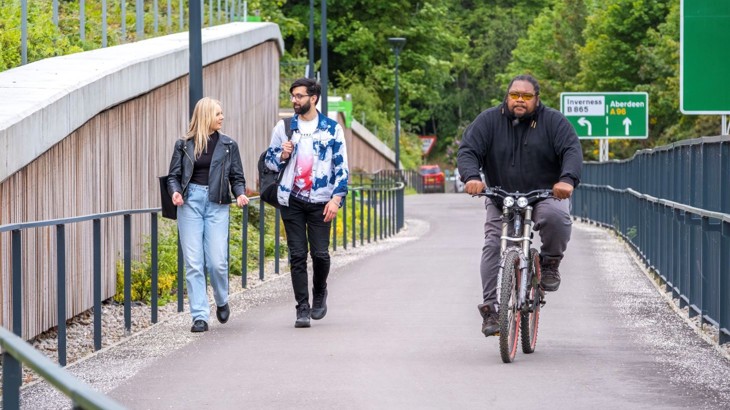The latest data collected by Sustrans reveals new walking, wheeling and cycling links delivered through Places for Everyone have helped improve safety and health as well as reduced inequality and pollution.

The South City Way has connected Glasgow's Southside with the City Centre. Credit: McAteer.
Since 2016, Sustrans Scotland’s infrastructure programme, Places for Everyone, has delivered over 111 miles of cycle, pedestrian or shared use paths.
Nearly half of these are newly constructed, with the remainder being upgrades to existing routes.
Thanks to these new paths, the number of people in Scotland living within 500m of high quality active travel infrastructure constructed through Places for Everyone has tripled between 2016 and 2024.
New analysis, carried out by Sustrans’ Research and Monitoring Unit (RMU), reveals the impact this new infrastructure is having on people and communities.
More people are getting active
The research estimates that the new paths have resulted in over 1.3 million more trips per year made by people choosing to walk, wheel and cycle after projects were delivered.
This is an increase of 28% in active travel trips per year.
For walking, there were 600,000 additional trips (an increase of 16%), whilst there were 700,000 more cycling trips (an increase of 85%).
This analysis likely underestimates the true increase in trips, as it is based on only a sample of projects – the true figures are potentially much higher.
Overall, the results suggest that the programme has significantly boosted health outcomes by increasing physical activity amongst people and communities.
Across newly delivered projects, 94% of people who responded agreed that a desire 'to get exercise' influenced their choice to walk, wheel or cycle along one of the routes.

The City Centre West to East Link has made it safer to cycle across the capital. Credit: Colin Hattersley.
Cleaner air and quieter streets
Results also indicate there has been a corresponding reduction in car travel, with surveys showing some active travel trips along new routes are replacing journeys by car.
As a result, levels of noise and air pollution have reduced, making neighbourhoods healthier and more pleasant to move around for local people.
Across a sample of five project sites, the estimated carbon emission rates from vehicles have reduced by 7% on average.
South City Way in Glasgow showed the greatest reduction, with emissions down by 53%.
Noise pollution is one of the biggest environmental pollutants, second only to air pollution as a driver of health problems.
Overall, there was an average decrease of 1.0 decibels across all five sites.
The largest decreases came from sites which saw the biggest drop in traffic volume.

Glasgow's South City Way has seen an increase in active travel and a decrease in emissions. Credit: McAteer.
Active travel saves lives
As well as improving health through increased physical activity and reduced pollution, analysis also shows that projects have significantly improved safety for people and communities.
As reported last year, the total number of casualties has decreased where new routes have been built.
For example, seven years before project construction, casualty rates varied from 0.1 to 0.35 casualties per km, whereas three years after construction rates ranged from 0 to 0.05 per km.
This is despite a corresponding increase in walking, wheeling and cycling journeys.
In response to surveys, more people also reported feeling safe after improvements had been made.
Before project delivery, 77% of survey respondents reported feeling safe on project sites, rising to 89% after completion.
Carole Patrick, UK Director for the National Cycle Network at Sustrans, said:
“We know from our Walking and Cycling Index reports and our work with communities across Scotland that people want to walk, wheel and cycle more – but safety is the main barrier they face.
“This report shows the crucial role Places for Everyone has played across Scotland in improving safety for people travelling actively and for all road users.
“With safe and convenient routes, more people than ever before are feeling confident to choose to walk, wheel or cycle – in turn benefitting their health, their wallets, and our local environment.”

Traffic free links like this one in Inverness are encouraging more people to walk, wheel and cycle. Credit: McAteer.
New routes are helping reduce inequality - but gaps remain
Results also show that completed Places for Everyone projects are helping encourage more active travel among protected groups.
Schools with projects located within 500m have substantially higher rates of walking, wheeling and cycling to school compared to the Scottish average.
The Children’s Walking and Cycling Index shows children in Scotland want safer infrastructure for walking, wheeling and cycling – 77% support more segregated cycle paths along roads.
In terms of gender, both men and women made more trips on Places for Everyone routes after construction.
The number of trips has also increased across every age group.
However, because the overall number of trips has increased, the proportion of women making trips on Places for Everyone routes has remained similar.
Other groups often under-represented in active travel include people from minority ethnic groups and those living with disabilities.
Following project completion, the proportion of route user survey respondents from minority ethnic groups using the new routes increased, although they remain underrepresented.
Similarly, the proportion of respondents with a long-term health condition has increased slightly but remains below the population average.
Another aim of the programme was to increase walking, wheeling and cycling rates amongst people who live in areas identified as ‘deprived’ according to the Scottish Index of Multiple Deprivation.
Up to five years after completion, the number of trips made by people from more deprived areas has nearly doubled from around 97,000 annually to 184,000, an 89% increase.
However, this group remains underrepresented on Places for Everyone routes.

Protected groups remain underrepresented on Places for Everyone routes. Credit: McAteer.
Where can I read the full report?
The excel-based report is available on request.
Please contact [email protected] for more information.
What is Places for Everyone?
Through Places for Everyone the Scottish Government provides millions of pounds to local authorities and community groups every year in order to help create new and accessible walking, wheeling and cycling connections across Scotland, from the Scottish Borders to the Western Isles.
In 2023-24 alone, £76m was invested in active travel infrastructure via Places for Everyone, making this the largest active travel programme in Scotland at nearly 46% of the total investment.





